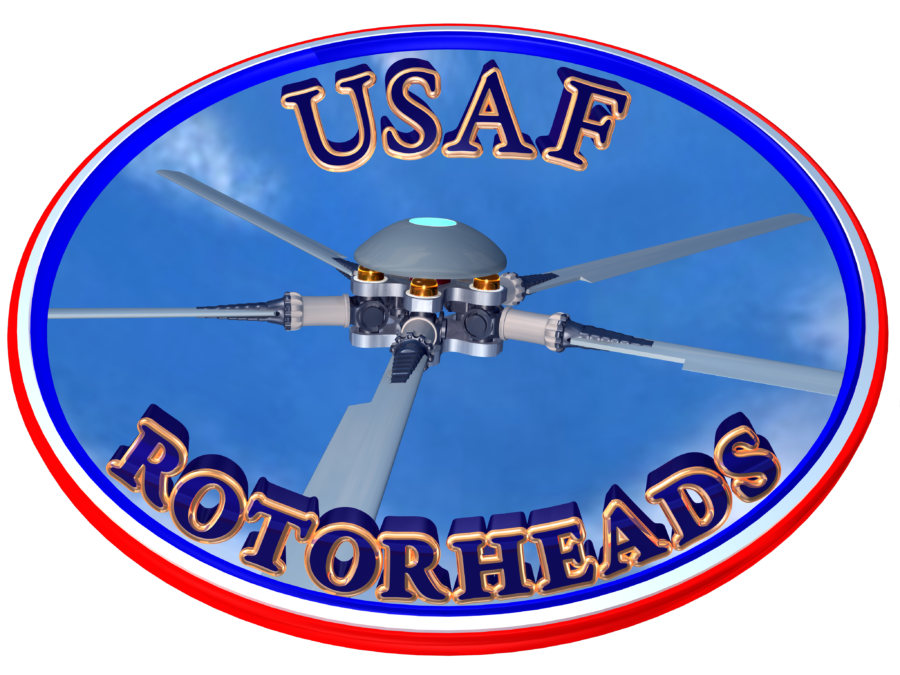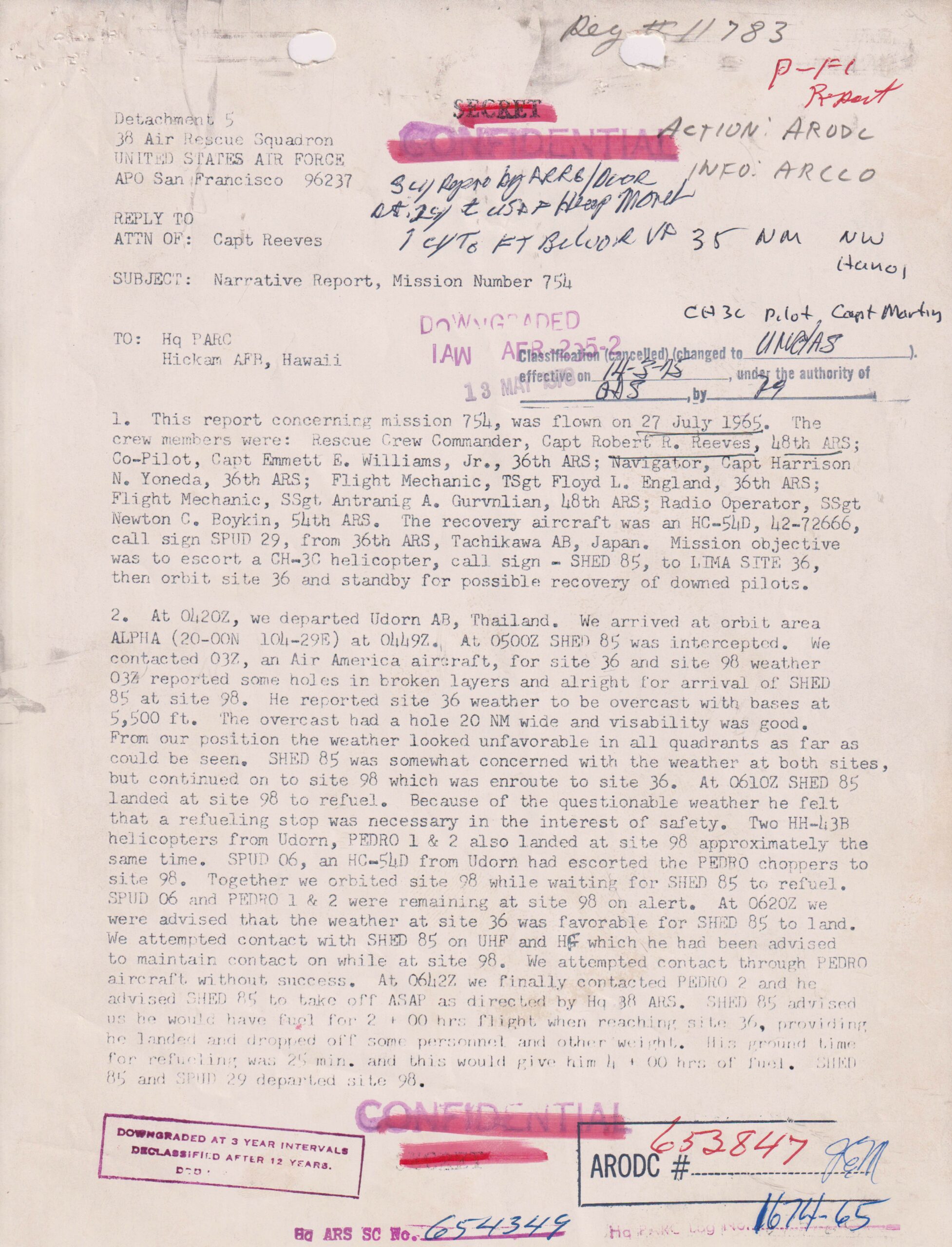Unit History
This section is reserved for Unit History Reports and/or other significant unit historical information. Most history reports were accomplished quarterly. If you have any such history reports and would like to have them posted here send them to USAF ROTORHEADS
20th Special Operations Squadron
(Green Hornets)
The following is an extract from the:
History Report
20th Special Operations Squadron
1 January – 31 March 1969
“DECLASSIFIED”
COURTESY OF JIM O’GORMAN
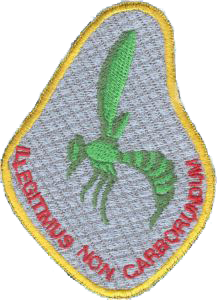 On 26 March 1969 our Commander, Lt Col Frank A. DiFiglia was killed in a helicopter crash. His untimely death and cause is fully documented below. Upon his death Lt Col David K. Sparks assumed Command.
On 26 March 1969 our Commander, Lt Col Frank A. DiFiglia was killed in a helicopter crash. His untimely death and cause is fully documented below. Upon his death Lt Col David K. Sparks assumed Command.
During this reporting period the 20th SOS lost three aircraft to hostile fire and unknown causes. Five men lost their lives and two men were wounded. These accidents together with the loss of aircraft documented in the proceeding reporting period have placed an unbearable burden on the 20th. Unbearable, because it has severely taxed the already limited resources of men and aircraft. This problem is so acute that minor problems such as radio communications and maintenance delays pale in significance to this great loss of men and airplanes.
Despite the severe losses, the men of the 20th are dedicated to the mission. Morale remains high. Replacement aircraft have been obtained in the past by levying a demand on Strategic Air Command UH-1F inventories. This source of aircraft has been cut off. Alternative sources such, as bringing aircraft from Tan Son Nhut and Udorn would require us to drop our missions and commitments at these locations. No solution to this problem has yet been found.
On 3 January 1969 UH-1F 63-13164 was shot down by hostile fire. The crash occurred near Duc Lap SVN. Sergeant Ronald P. Zenga was pinned under the aircraft and died in the ensuing fire. The crew consisting of Major Paul E. McClellan, aircraft commander, Major Thomas Courtney, pilot and Sergeants Jess P. Rowland and Ronald P. Zenga were attempting to rescue a Special Forces reconnaissance patrol. The patrol was in contact with an unknown size enemy and in danger of being circled and overrun. After Green Hornet gunships had suppressed the enemy groundfire, a slick helicopter attempted a McGuire  Rig extraction only to encounter intense fire upon coming to a hover. The slick was badly damaged and its radio knocked out. After taking eight hits the slick departed the area and again gunships suppressed the enemy fire. Major McClellan and crew then approached for a second attempted pickup. As they came to a hover above the trees enemy fire struck the fuel cells setting the aircraft on fire. They were able to accelerate the aircraft and attempted a landing in a small jungle clearing less than 500 meters from enemy forces surrounding the Special Forces patrol. The engine failed just short of the clearing and the helicopter crashed into the trees. Sergeant Zenga was pinned beneath the overturned aircraft, Major Courtney was knocked unconscious, and Sergeant Rowland was entangled in his harness. Major McClellan was able to get out of the wreckage and remove Major Courtney and Sergeant Rowland just prior to the aircraft bursting into flames. Another slick landed nearby and assisted in rescuing the downed crew.
Rig extraction only to encounter intense fire upon coming to a hover. The slick was badly damaged and its radio knocked out. After taking eight hits the slick departed the area and again gunships suppressed the enemy fire. Major McClellan and crew then approached for a second attempted pickup. As they came to a hover above the trees enemy fire struck the fuel cells setting the aircraft on fire. They were able to accelerate the aircraft and attempted a landing in a small jungle clearing less than 500 meters from enemy forces surrounding the Special Forces patrol. The engine failed just short of the clearing and the helicopter crashed into the trees. Sergeant Zenga was pinned beneath the overturned aircraft, Major Courtney was knocked unconscious, and Sergeant Rowland was entangled in his harness. Major McClellan was able to get out of the wreckage and remove Major Courtney and Sergeant Rowland just prior to the aircraft bursting into flames. Another slick landed nearby and assisted in rescuing the downed crew.
On 13 February 1969 UH-1F 64-15492 was shot down by hostile groundfire near Duc Co. The crew consisted of Captain Ronald Andrews, aircraft commander, Major Ronald H. Guy, pilot and Technical Sergeant Jesse C. Bowman and A1C Isidro Arroyo, gunners. Again a Special Forces patrol was in contact with a large enemy force, and again 20th SOS gunships came in to suppress the enemy fire long enough for the slick aircraft to extract the patrol. On the first gun pass, the aircraft was hit and immediately fuel fumes choked the crew. Within seconds the aircraft fuel tanks were in flames. Captain Andrews landed his flaming aircraft a scant kilometer away from the hostile forces. Again another 20th SOS slick landed nearby and rescued the crew as the airplane went up in flames.
On 26 March 1969 UH-1F 63-13158 was enroute from Ban Me Thuot to Nha Trang with a total of ten persons on board. The aircraft crashed and burned near Duc My, some 12 minutes flying time north of Nha Trang Air Base. Of the ten persons onboard 2 survived. Dead were Lt Col Frank A. DiFiglia the aircraft commander, Colonel Donald G. Lepard, 14 Special Operations Wing Deputy Commander for Special Operations, Colonel J. B. Levesque, 14th SOW Deputy Commander for Material, Captain (Dr.) Robert W. Fields, 20th SOS Flight Surgeon, Captain Walter C Booth, 20th SOS Maintenance Officer, Technical Sergeant Jesse C. Bowman, 20th SOS Gunner, and Sergeant Antonio L. Alho, 20th SOS Gunner, also dead was Mr. Abb Greer, Bell Helicopter Company Technical Representative. Critically wounded were Sergeants James E. O’Gorman and David E. Joslin. The investigating board determined that the crash sequence began at 4 to 5 thousand feet MSL when a severe vibration or beat was noted and autorotation initiated. During the descent and forced landing, control of the aircraft was lost causing subsequent destruction of the main rotor which in turn severed the tail boom. The board determined that the escalation of events from the initial severe beat or vibration through impact progressed to a point where aircraft control was impossible to maintain. First the severe beat, then the uncontrollability, followed by the separation of aircraft access doors, subsequently the main rotor underwent violent stresses and severed the tail boom. The board concluded that the chain of events began with the catastrophic failure which was probably caused by hostile fire impacting on a critical component causing an unbalanced condition or failure leading to a severe beat or vibration.
During this reporting period men of the 20th SOS were awarded the following decorations:
2 Purple Hearts
16 Distinguished Flying Crosses
32 Air Medals
On 1 March 1969 1st Lt James P. Fleming was notified that he had been nominated for the Medal of Honor. On 26 Nov 1968 Lt Fleming had rescued a Special Forces patrol despite intense hostile fire and complete disregard for his own personal safety.
20th Helicopter Squadron
(Pony Express)
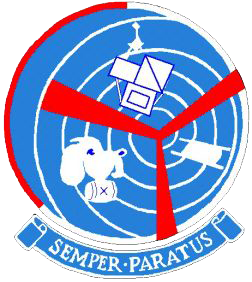
"Green Berets" of the Army Special Forces are perhaps the best known of the U.S. military's special operations forces, followed by the Navy's SEALs. But the Air Force was there at the beginning as well. Among the first such Special Forces was what is today the Air Force 20th Special Operations Squadron. On October 8, 1965, the 20th Helicopter Squadron (later redesignated the 20th Special Operation Squadron) was formed at Tan Son Nhut Air Base, outfitted with 14 Sikorsky CH-3C helicopters. The 20th's primary mission was considerable in scope-to augment combat search-rescue forces, perform casualty evacuation, support communications sites as well as airfield construction and the tactical air control system, transport air liaison officers and engage in counterinsurgency. The squadron's secondary mission was to support MACV. The 20th began combat operations in December 1965. By March of 1966 the squadron was flying an average of nearly 1000 sorties per month from Tan Son Nhut (home base to A FLIGHT, with five aircraft), from Da Nang (B Flight with three aircraft) and from Nha Trang (C flight, with six aircraft)
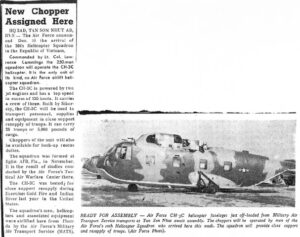
THIS NEWS ARTICLE APPEARED IN THE DEC 17, 1965 ISSUE OF "THE AIR DIVISION REPORTER", PUBLISHED FOR THE HQ 2ND AIR DIVISION, PACIFIC AIR FORCES IN SOUTH VIETNAM. JIM MARDOCK WAS A MEMBER OF THE 20HS ATTHIS TIME.

THIS PICTURE WAS PROVIDED BY JOHAN RAGAY. IT IS A 1965 USAF PHOTO THAT JOHAN DISCOVERED DURING HIS MANY HOURS OF RESEARCH OF THE H-43. THERE WERE SEVERAL SUGGESTIONS AS TO THE LOCATION AND OWNERSHIP OF THE AIRCRAFT. JIM MARDOCK THEN PROVIDED THE BELOW NEWS ARTICLE.
NOTE: JIM MARDOCK IS WORKING TO IDENTIFY THE TAIL NUMBERS OF THE 14 HELICOPTERS. IF YOU CAN HELP CONTACT US.
31st Rescue Squadron

Lineage
Constituted 31 Air Rescue Squadron on 17 Oct 1952. Activated on 14 Nov 1952. Discontinued on 18 Sep 1960. Organized on 8 Jul 1963. Redesignated 31 Aerospace Rescue and Recovery Squadron on 8 Jan 1966. Inactivated on 1 Jul 1975. Activated on 8 Jan 1981. Redesignated 31 Special Operations Squadron on 6 Apr 1989. Inactivated on 31 Aug 2001. Redesignated 31 Rescue Squadron on 16 May 2003. Activated on 31 Jul 2003.
Assignments
2 Air Rescue Group, 14 Nov 1952; Air Rescue Service, 24 Jun 1958-18 Sep 1960. Air Rescue (later, Aerospace Rescue and Recovery) Service, 8 Jul 1963 (attached to Pacific Air Rescue [later, Pacific Aerospace Rescue and Recovery] Center, 8 Jul 1963-31 Mar 1967); Pacific Aerospace Rescue and Recovery Center (later, 41 Aerospace Rescue and Recovery Wing), 1 Apr 1967-1 Jul 1975. 41 Rescue and Weather Reconnaissance Wing, 8 Jan 1981; 353 Special Operations Wing (later, 353 Special Operations Group) 6 Apr 1989-31 Aug 2001. 18 Operations Group, 31 Jul 2003-.
Stations
Clark AB, Philippines, 14 Nov 1952; Naha AB, Okinawa, 12-18 Sep 1960. Clark AB, Philippines, 8 Jul 1963-1 Jul 1975. Clark AB, Philippines, 8 Jan 1981; Marine Corps Air Station, Futemna, Okinawa, Japan, 29 Jun 1991; Osan AB, South Korea, Jul 1992-31 Aug 2001. Kadena AB, Japan, 31 Jul 2003-.
Commanders
Maj Sherwin G. Desens, c. 14 Nov 1952-unkn; Lt Col Edward P. Langebartel, by Jun 1955; Lt Col Frank M. Allen, 21 Jun 1955; Maj Reuben J. Brown Jr., 1 Jul 1956; Maj Frederick E. Weigand, 26 Jul 1956; Lt Col George P. Bahler, 6 Sep 1956; Lt Col Felix G. Brenner, 1 Apr 1958; Maj Alexander S. Sherry, c. Jun 1960; Maj Willard D. Welch, by Jul 1960; Lt Col Ernest M. Magee, c. 27 Jul-c. 18 Sep 1960; none (not manned) 18 Sep 1960-7 Jul 1963; Maj Cortez C. Brown, 8 Jul 1963; Lt Col Gardner W. Kendall, 25 Aug 1963; Lt Col Karol F. Rybos, 29 May 1965; Lt Col Melbourne J. Nibe, 2 Aug 1966; Lt Col George C. Pinyerd, 2 Jun 1968; Lt Col Robert Galt Jr., 6 Jun 1970; Lt Col James J. Krajicek Jr., 30 Jun 1970; Lt Col Carl W. Olsson, c. Jul 1972; Lt Col Herbert D. Kalen, 1 Jan 1975; Lt Col Richard H. Smith, 24 Jan-1 Jul 1975. Lt Col Doyle W. Krauss, 8 Jan 1981; Lt Col Robert P. Starnes, 19 Jun 1981; Lt Col Robert M. Stankovich, 12 Jun 1984; Lt Col Thomas C. Marsh, 12 May 1986; Lt Col Dale J. Cook, 18 May 1988; Lt Col Lee T. Massey, 14 Aug 1990; Lt Col Eugene A. Correll, 18 Dec 1991; Lt Col Craig R. Jensen, 20 Dec 1993; Lt Col Bob L. Hunt, 13 Dec 1994; Lt Col Lyle M. Koenig Jr., 7 Jul 1995; Lt Col Clayton P. Spriet, 26 Jul 1996; Lt Col Steven F. Dreyer, 4 Aug 1997; Lt Col T. Tracey Goetz, 3 Aug 1998; Lt Col Steven R. Otto, 16 Jul 1999; Lt Col Brendan G. Clare, 30 Jun 2000-30 Jun 2001; unkn, Jul-31 Aug 2001. Maj Coy Speer, 31 Jul 2003; Maj Charles E. Metrolis Jr., 24 Jun 2005-.
Aircraft
SA-16, 1952-1960; H-19, 1952-1955; SH-19, 1955-1960. HH-19, 1963-1964; HC-54, 1964-1965; HH-43, 1964-1970, 1971-1972; HC-97, 1965-1966; HC-130, 1966-1975; HH-3, 1968-1975. HH-3, 1981-1990; CH-3, 1981-1990; MH-53, 1990-2001; MH-47, 2001.
Operations
Combat rescue in Southeast Asia, 1965-1966. Operated Joint Rescue Coordination Center for Thirteenth Air Force, Apr 1967-Jul 1975. Supported evacuation of Saigon, South Vietnam, flying 108 hours in combat search and rescue, Feb-May 1975. Provided rotary wing search and rescue capabilities in Southwest Pacific area, 1981-1989, and rotary wing unconventional warfare and special operations resources in the Far East, 1990-2001. Operated no aircraft; served as all-parachute jump unit, 2003-.
Service Streamers
None
Campaign Streamers
None
Armed Forces Expeditionary Streamers
None
Decorations
Air Force Outstanding Unit Award with Combat "V" Device: 12 Feb-17 May 1975. Air Force Outstanding Unit Awards: 1 Jul 1964-30 Jun 1966; 1 Jul 1966-31 May 1968; 1 Jun 1969-31 May 1971; 1 Jun 1971-31 May 1973; 1 Jun 1973-31 May 1975; [8 Jan]-15 Jun 1981; 1 Apr 1984-31 Mar 1986; 1 Apr 1986-31 Mar 1988; 6 Apr 1989-5 Apr 1991; 1 Jun 1993-31 May 1995; 1 Sep 1995-31 Aug 1997; 16 Oct 1998-31 May 2000; 13 Oct 2000-[31 Aug 2001]; 31 Jul 2003-30 Sep 2004. Meritorious Unit Citation (Navy): 1 Jul 1967-26 Jul 1969. Republic of Vietnam Gallantry Cross with Palm: 1 Apr 1966-17 Jan 1967. Philippine Republic Presidential Unit Citation: 21 Jul-15 Aug 1972.
Lineage, Assignments, Stations, and Honors through 17 Oct 2007.
Commanders, Aircraft, and Operations through Oct 2007.
Supersedes statement prepared on 14 Jul 2003.
Emblem. Approved 15 Sep 1993.
Prepared by Patsy Robertson.
Reviewed by Daniel Haulman.
33rd Rescue Squadron
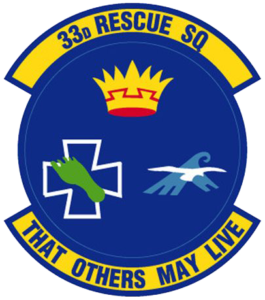
Lineage
Constituted 33 Air Rescue Squadron on 17 Oct 1952. Activated on 14 Nov 1952. Discontinued on 18 Mar 1960. Organized on 18 Jun 1961. Redesignated: 33 Air Recovery Squadron on 1 Jul 1965; 33 Aerospace Rescue and Recovery Squadron on 8 Jan 1966. Inactivated on 1 Oct 1970. Activated on 1 Jul 1971. Redesignated: 33 Air Rescue Squadron on 1 Jun 1989; 33 Rescue Squadron on 1 Feb 1993.
Assignments
2 Air Rescue Group, 14 Nov 1952 (attached to Twentieth Air Force, 14 Nov 1952-1 Mar 1955; 3 Air Rescue Group, 1 Mar-19 Sep 1955); 3 Air Rescue Group, 20 Sep 1955; 2 Air Rescue Group, 18 Jun 1957; Air Rescue Service, 24 Jun 1958-18 Mar 1960 (attached to Pacific Air Forces, 24 Jun 1958-17 Mar 1959; Detachment 2, Air Rescue Service [Pacific Recovery Operations Center], 18 Mar 1959-18 Mar 1960). Air Rescue (later, Aerospace Rescue and Recovery) Service, 18 Jun 1961 (attached to Detachment 1, Air Rescue Service [Pacific Recovery Operations Center], 18 Jun-8 Oct 1961; Pacific Air Rescue Center [later, Pacific Aerospace Rescue and Recovery Center], 8 Oct 1961-31 Mar 1967); Pacific Aerospace Rescue and Recovery Center (later, 41 Aerospace Rescue and Recovery Wing), 1 Apr 1967-1 Oct 1970. 41 Aerospace Rescue and Recovery (later, 41 Rescue and Weather Reconnaissance) Wing, 1 Jul 1971; Air Rescue Service, 1 Aug 1989; 18 Operations Group, 1 Feb 1993-.
Stations
Kadena AB, Okinawa, 14 Nov 1952; Naha AB, Okinawa, 14 Apr 1955-18 Mar 1960. Naha AB, Okinawa, 18 Jun 1961-1 Oct 1970. Kadena AB, Okinawa, 1 Jul 1971-.
Commanders
Maj Malcolm E. Frazee, 14 Nov 1952; Lt Col Raleigh C. Smith, 7 May 1954; Lt Col Donald R. Calof, 6 Jul 1956; Maj Horatio L. Holton Jr., 1 Jul 1958; Maj Bill C. Musick, 25 Jul 1958; Maj Horatio L. Holton Jr., Oct 1958; Lt Col Clyde W. Bradley Jr., 11 Nov 1958-18 Mar 1960. Lt Col Ernest M. McGee, 18 Jun 1961; Lt Col Robert P. Ash Sr., 8 Nov 1962; Lt Col Kenneth J. Mask, 13 Dec 1963; Col Donald E. Godbey, 24 Feb 1964; Lt Col Roy E. Jacobsen, 28 May 1966; Lt Col Anthony Saenz Jr., 15 Jul 1968; Lt Col Ronald L. Ingraham, 14 Aug 1968; Lt Col Donald G. Simpson, 23 Apr-1 Oct 1970. Lt Col Roy L. Crawford, 1 Jul 1971; Lt Col Ned L. Cagle, 18 Nov 1972; Lt Col James R. Lisko, 12 Jun 1974; Lt Col James L. Butera, 11 Jul 1975; Col Ryland R. Dreibelbis, 15 Jul 1977; Col John H. Denham, 31 May 1979; Lt Col Peter J. Connelly, 7 Jan 1981; Lt Col Walter R. Peacock Jr., 9 Nov 1982; Lt Col George H. Dash Jr., 13 Jun 1984; Lt Col David M. Myers, 24 Jun 1986; Lt Col Thomas A. Samples, 24 Nov 1987; Lt Col James C. Johnson, unkn; Lt Col Herbert R. Smith, 1 Jun 1993; Lt Col Michael J. Iltis, 26 May 1995; Lt Col Derek Wheeler, 25 May 1996; Lt Col Mark Bracich, 8 Jun 1998; Lt Col Michael A. Corbett, 18 Jan 2000; Lt Col Neil R. Elton, 26 Nov 2001; Lt Col Billy D. Thompson, 29 May 2003; Lt Col Gary W. Henderson, 17 May 2005-.
Aircraft
SA-16, 1952-1960; SH-19, 1952-1960; SC-47, 1952-1956. SA-16 (later, HU-16), 1961-1968; SH-19 (later, HH-19), 1961-1964; HH-43, 1964-1966; C-54, 1966; HH-3, 1968-1970; HC-97, 1968-1969. HH-43, 1971-1972; HH-3, 1971-1975, 1982-1994; HC-130, 1972-1989; HH-53, 1975-1982; CH-3, 1982-1994; HH-60,1993-.
Operations
Search, rescue and recovery, 1952-1960, 1961-1970, 1971-, including Vietnam, 1965-1967; following the seizure of the USS Pueblo by North Korea, 29 Jan-16 Sep 1968; and search efforts and salvage operations, Sep-Oct 1983, after a Soviet fighter aircraft shot down South Korean airliner KAL 007. Provided search, rescue and recovery services supporting US national interests in the Pacific theater, 1993-.
Service Streamers
Korean Theater.
Campaign Streamers
Vietnam: Vietnam Advisory; Vietnam Defensive; Vietnam Air; Vietnam Air Offensive; Vietnam Air Offensive, Phase II.
Armed Forces Expeditionary Streamers
None.
Decorations
Air Force Outstanding Unit Awards: 1 Jul 1956-31 Dec 1958; 15 Jun 1964-31 May 1965; 1 Jun 1965-30 Jun 1966; 1 Jul 1966-31 May 1968; 1 Jun 1969-30 Sep 1970; 1 Jun 1973-31 May 1975; 1 Sep 1975-1 May 1977; 16 Jul 1977-16 Jul 1979; 17 Jul 1979-15 Jun 1981; 1 Apr 1984-31 Mar 1986; 1 Apr 1987-31 Mar 1988; 1 Jun 1991-31 May 1993; 1 Jun 1993-31 Aug 1994; 1 Sep 1995-31 Aug 1997; 1 Oct 1998-30 Sep 2000; 1 Oct 2000-30 Sep 2002; 1 Oct 2002-30 Sep 2004. Navy Meritorious Unit Commendation: 1 Jul 1967-26 Jul 1969. Republic of Vietnam Gallantry Cross with Palm: 1 Apr 1966-17 Jan 1967.
Lineage, Assignments, Stations, and Honors through 17 Oct 2007.
Commanders, Aircraft, and Operations through Oct 2007.
Supersedes published information contained in: Judy G. Endicott (ed.), USAF Active Flying, Space, and Missile Squadrons as of 1 October 1995 (Washington: USPGO, 1999).
Emblem. Approved on 21 Mar 1978.
Prepared by Patsy Robertson.
Reviewed by Daniel Haulman.
38th Rescue Squadron

Lineage
Constituted 38 Air Rescue Squadron on 17 Oct 1952. Activated on 14 Nov 1952. Inactivated on 18 Sep 1957. Activated on 30 Jun 1965. Organized on 1 Jul 1965. Redesignated 38 Aerospace Rescue and Recovery Squadron on 8 Jan 1966. Inactivated on 1 Jul 1971. Activated on 1 Jul 1978. Redesignated: 38 Air Rescue Squadron on 1 Jun 1989; 38 Rescue Squadron on 1 Feb 1993; 38 Rescue Flight on 1 Jul 1994. Inactivated on 15 Feb 1996. Redesignated 38 Rescue Squadron on 2 Apr 2001. Activated on 1 May 2001.
Assignments
3 Air Rescue Group, 14 Nov 1952 (attached to HQ Far East Air Forces for operational control, 14 Nov 1952-1 Jul 1954; Japan Air Defense Force, 1 Jul-1 Aug 1954; HQ Far East Air Forces [later, Pacific Air Forces], 1 Aug 1954-c. 18 Sep 1957); 2 Air Rescue Group, 18 Jun-18 Sep 1957. Military Air Transport Service, 30 Jun 1965; Air Rescue Service, 1 Jul 1965 (attached to 2 Air Division for operational control, 1 Jul 1965-c. 7 Jan 1966); 3 Aerospace Rescue and Recovery Group, 8 Jan 1966-1 Jul 1971. 39 Aerospace Rescue and Recovery Wing, 1 Jul 1978; 41 Rescue and Weather Reconnaissance Wing, 8 Jan 1981; Air Rescue Service, 1 Aug 1989; 51 Operations Group, 1 Feb 1993-15 Feb 1996. 347 Operations Group, 1 May 2001-.
Stations
Misawa AB, Japan, 14 Nov 1952-18 Sep 1957. Tan Son Nhut Afld (later, AB), South Vietnam, 1 Jul 1965-1 Jul 1971. Homestead AFB, FL, 1 Jul 1978-8 Jan 1981; Osan AB, South Korea, 8 Jan 1981-15 Feb 1996. Moody AFB, GA, 1 May 2001-
Commanders
Lt Col John E. McClure, 14 Nov 1952; Lt Col Joe D. Wheeler, 21 May 1953; Lt Col Roy Parnell, 13 Sep 1954; Maj Jack O. McReynolds, 12 Jul 1957; Maj Arthur W. Rochlin, 7 Aug-18 Sep 1957. Lt Col Edward Krafka, 1 Jul 1965; Lt Col Donald F. Karschner, 16 Oct 1965; Col Arthur W. Beall, 18 Nov 1965; Lt Col James L. Blackburn, 8 Jan 1966; Lt Col John A. Price, 4 Sep 1966; Lt Col Norman V. Rudrud, 14 Sep 1967; Lt. Col Edward J. Renth Jr., 22 Nov 1967; Lt Col James L. Price, 5 Jul 1969; Lt Col Donald E. Jensen, by 30 Jun 1970; Lt Col John F. Ward, by 30 Jun-1 Jul 1971. Lt Col James W. McElhaney, 1 Jul 1978; Lt Col Robert S. Michelsen, 11 Apr 1979; Lt Col Douglas M. Wendt, 18 Jul 1980; Lt Col Richard M. Baskett, 8 Jan 1981; Lt Col Forest M. Kimsey, 19 Aug 1981; Lt Col Richard G. Gasparian, by Jan 1983; Lt Col Raymond L. Stephens, 17 Jul 1984; Lt Col Ronald J. Sergott, 7 Jun 1985; Lt Col Theodore McKnight 26 Aug 1986; Lt Col Michael D. Gregersen, c. 17 Jul 1987; Lt Col Ronald E. Dietz, 20 Jul 1988; Lt Col Jack E. McPhie, by Jul 1989; Lt Col Thomas R. Friers, c. 27 Sep 1990; Lt Col Kenneth C. Stanley Jr., 1 Jul 1992; Lt Col Michael J. Hoelzel, 15 Jul 1993; Lt Col Page A. Wagner III, 30 Jun 1994; Maj Mark E. Bracich, 20 Jul 1995-15 Feb 1996.
Aircraft
SA-16, 1952-1957; H-5, 1953; H/SH-19, 1954-1957. CH/HH-3, 1965-1966; HH-43, 1965-1971. UH-1, 1978-1980; CH-3, 1979-1980, 1981-1990; HH-3, 1980, 1981-1990; HH-60, 1990-1995.
Operations
Search, rescue, and recovery in Japan and adjacent waters, 1952-1957; also in Korea and adjacent waters, 1952-1953. Operated 14 search and rescue detachments in Vietnam and Thailand, 1965-1971. Provided light-lift helicopter operations east of the Mississippi River, 1978-1980. Flew rescue helicopter operations in South Korea and adjacent waters, 1981-1995.
Service Streamers
None
Campaign Streamers
Korea: Korea Summer-Fall 1952, Third Korean Winter; Korea Summer 1953. Vietnam: Vietnam Defensive; Vietnam Air; Vietnam Air Offensive; Vietnam Air Offensive, Phase II; Vietnam Air Offensive, Phase III; Vietnam Air/Ground; Vietnam Air Offensive, Phase IV; Tet 69/Counteroffensive; Vietnam Summer-Fall, 1969; Vietnam Winter-Spring, 1970; Sanctuary Counteroffensive; Southwest Monsoon; Commando Hunt V; Commando Hunt VI.
Armed Forces Expeditionary Streamers
None
Decorations
Distinguished Unit Citation: Korea, 1 May-27 Jul 1953. Presidential Unit Citations (Southeast Asia): [1 Jul]-31 Jul 1965; 1 Aug 1965-30 Jun 1966; 1 Jul 1967-31 Jan 1969; 1 Feb 1969-30 Apr 1970; 1 May 1970-1 Jul 1971. Air Force Outstanding Unit Award with Combat "V" Device: 1 Jul-31 Dec 1966. Air Force Outstanding Unit Awards: [8 Jan]-15 Jun 1981; 1 Apr 1984-31 Mar 1986; 1 Apr 1986-31 Mar 1988; 1 Oct 1992-30 Sep 1994; 1-30 Nov 1995. Republic of Korea Presidential Unit Citation: [14 Nov 1952]-31 Mar 1953. Republic of Vietnam Gallantry Cross with Palm: 1 Apr 1966-[1 Jul 1971].
Lineage, Assignments, Components, Stations, and Honors through 16 Apr 2002.
Commanders, Aircraft, and Operations through Dec 1996.
Supersedes statement prepared on 20 Sep 1994.
Emblem. Approved on 2 Oct 2001.
Prepared by A. Timothy Warnock.
Approved by Judy G. Endicott.
41st Rescue Squadron

Lineage
Constituted as 41 Air Rescue Squadron on 17 Oct 1952. Activated on 14 Nov 1952. Discontinued, and inactivated, on 18 Mar 1960. Activated on 29 Dec 1961. Organized on 8 Jan 1962. Redesignated as 41 Aerospace Rescue and Recovery Squadron on 8 Jan 1966. Inactivated on 30 Sep 1987. Activated on 1 Mar 1989. Redesignated: 41 Air Rescue Squadron on 1 Jun 1989; 41 Rescue Squadron on 1 Feb 1993.
Assignments
4 Air Rescue Group, 14 Nov 1952; Air Rescue and Recovery Service, 8 Dec 1956-18 Mar 1960. Military Air Transport Service, 29 Dec 1961; Air (later, Aerospace) Rescue and Recovery Service, 8 Jan 1962; 39 Aerospace Rescue and Recovery Wing, 1 Jan 1970; 41 Rescue and Weather Reconnaissance Wing, 1 Sep 1975-30 Sep 1987. 41 Rescue and Weather Reconnaissance Wing, 1 Mar 1989 (attached to Eastern Space and Missile Center for operational control, 1 Mar 1989-); Air Rescue Service, 141 Rescue Squadron Aug 1989; 1 Operations Group, 1 Feb 1993; 1 Rescue Group, 14 Jun 1995; 347 Operations (later, 347 Rescue) Group, 1 Apr 1997-.
Stations
Hamilton AFB, CA, 14 Nov 1952-18 Mar 1960. Hamilton AFB, CA, 8 Jan 1962; McClellan AFB, CA, 1 Aug 1973-30 Sep 1987. Patrick AFB, FL, 1 Mar 1989; Moody AFB, FL, 1 Apr 1997-.
Commanders
Maj Thomas L. Shockley, 14 Nov 1952; Lt Col Frank H. Dreher, c. Sep 1953; Lt Col Robert L. Boardman, 6 Aug 1954; Maj William M. McDonald, 7 Nov 1955-unkn; Lt Col Felix G. Brenner, unkn-11 Mar 1958; Maj John H. Mork, 11 Mar 1958-unkn; Lt Col Robert A. Stribling, unkn; Lt Col John H. Mork, unkn; Lt Col Robert A. Stribling, unkn-c. 18 Mar 1960. Maj Robert E. Freshwater, 8 Jan 1962; Lt Col Edward Krafka, 6 Feb 1962; Lt Col Donald F. Karshner, 28 Sep 1964; Lt Col Cortez C. Brown, 5 Sep 1965; Lt Col Leslie E. Gamble, 27 May 1967 (acting); Lt Col Maynard R. Rhoades, 10 Jul 1967; Lt Col Joseph P. Leonelli, 20 Jun 1968; Lt Col Noble L. Webster Jr., 7 Nov 1969; Lt Col William H. Hatfield, 1 Jun 1971; Lt Col Philip S. Prince, 15 May 1972; Lt Col James Davis, 2 Jul 1973; Lt Col Charles E. Trapp Jr., 1 Mar 1976; Lt Col Richard W. Nelson, 5 Jun 1977; Lt Col Jack V. Butler, 29 May 1978; Lt Col Jon P. Woods, 16 Jun 1980; Lt Col Harold O. Jones, 7 Jul 1982; Lt Col James E. McArdle Jr., 7 Aug 1984; Lt Col Allan W. Rowe, 30 Jun 1986-30 Sep 1987. Lt Col John K. Rehkop, 1 Mar 1989; Lt Col J. Michael Bergstresser, Aug 1991; Lt Col Robert H. Holliway, 19 Aug 1993; Lt Col J. Michael Scannell, 15 Sep 1995; Lt Col John P. Grimes Jr., 22 May 1997; Lt Col John D. Nelson, 7 May 1999; Lt Col Michael F. Korcheck, 22 Nov 2000; Lt Col Lee K. De Palo, 22 Aug 2002; Lt Col Lee J. Pera, 18 Jun 2004; Lt Col John V. Dallin III, Jun 2006-.
Aircraft
SB-17, 1952-c. 1953; C-82, 1952-1953; H-5, 1952-c. 1953; SA-16, 1953-c. 1960; SH-19, c. 1953-c. 1960. SA/HU-16, 1962-1968; SH/HH-19, 1962-1963; HH-43, 1963; HC-130, 1966-1987; CH/HH-53, 1971-1973; HH-3, 1973-1976; HH-53, 1976-1987. HH-3, 1989-1994; HH-60, 1994-.
Operations
Conducted search and rescue to recover personnel and aerospace hardware in support of USAF global air and space operations; conducted numerous humanitarian rescue operations, 1952-1960, 1962-1987; and 1989-. Recovered high-altitude atmospheric-sampling devices, 1962-1987. Deployed aircraft and aircrews to Florida bases during Cuban Missile Crisis, Oct 1962. Beginning in Mar 1989, provided prelaunch security and safety surveillance of NASA launches and recovery or medical evacuation for Space Shuttle crewmembers. Conducted day and night (night vision goggles), low-level combat rescue, air refueling and survivor rescue, 1994-. During 1996-1997 deployed personnel and aircraft to Southwest Asia to provide combat search and rescue (CSAR). In 1999, took part in air operations over Serbia.
Service Streamers
None
Campaign Streamers
Kosovo: Air Campaign.
Armed Forces Expeditionary Streamers
None.
Decorations
Meritorious Unit Award: 1 Jun 2006-31 May 2007. Air Force Outstanding Unit Awards: 22-28 Dec 1955; 1 Apr 1968-31 Mar 1970; 1 Jul 1972-30 Jun 1974; 1 Sep 1975-1 May 1977; 16 Jul 1977-16 Jul 1979; 17 Jul 1979-15 Jun 1981; 1 Apr 1984-31 Mar 1986; 1 Apr 1987-[30 Sep 1987]; 1 Feb 1993-30 Apr 1994; 1 Sep-31 Dec 1999; 1 Jun 2002-31 May 2003; 1 Oct 2003-31 Oct 2004; 1 Nov 2004-31 Jul 2006.
Lineage, Assignments, Stations, and Honors through 20 Mar 2009.
Commanders through 18 Mar 2009, Aircraft, and Operations through 31 Dec 2005.
Supersedes published information contained in: Judy G. Endicott (ed.), USAF Active Flying, Space, and Missile Squadrons as of 1 October1995 (Washington: USGPO, 1999).
Emblem. On a Black bordered White disc, extending to border a Red curvilinear suspension bridge with Black outlined truss spanning a stylized expanse of Dark Blue water with wide White caps at top and narrower White caps toward base, the tatter half concealing a downed White plane all outlined Black. Overall above plane and Blue area of water, a stylized swooping Light Blue hawk, eyed White and with Yellow beak, feet and end of tail feathers, and with elevated wings. Approved on 24 May 1954(49781 A.C.).
Prepared by Patsy Robertson.
Reviewed by Daniel Haulman.
55th Rescue Squadron

Lineage
Constituted as 55th Air Rescue Squadron on 17 Oct 1952. Activated on 14 Nov 1952. Discontinued, and inactivated, on 18 Jun 1960. Activated on 10 May 1961. Organized on 18 Jun 1961. Redesignated as: 55 Aerospace Rescue and Recovery Squadron on 8 Jan 1966; 55 Special Operations Squadron on 1 Mar 1988. Inactivated on 11 Nov 1999. Redesignated as 55 Rescue Squadron on 22 Jan 2003. Activated on 14 Mar 2003.
Assignments
6 Air Rescue Group, 14 Nov 1952; Air Rescue Service, 18 Feb 1958-18 Jun 1960. Military Air Transport Service, 10 May 1961; Air Rescue (later, Aerospace Rescue and Recovery) Service, 18 Jun 1961; 39 Aerospace Rescue and Recovery (later, 39 Special Operations) Wing, 1 Jan 1970; 1 Special Operations Wing, 18 Apr 1989; 1 Special Operations (later, 16 Operations) Group, 22 Sep 1992-11 Nov 1999. 355 Operations Group, 14 Mar 2003; 563 Rescue Group, 1 Oct 2003-.
Stations
Thule AB, Greenland, 14 Nov 1952; Kindley AFB, Bermuda, 17 Mar-18 Jun 1960. Kindley AFB, Bermuda, 18 Jun 1961; McCoy AFB, FL, 27 Feb 1970; Eglin AFB, FL, 25 Jun 1971; Hurlburt Field, FL, 25 Feb 1993-11 Nov 1999. Davis-Monthan AFB, AZ, 14 Mar 2003-.
Commanders
Maj Melvin E. Bunch, 14 Nov 1952; Maj Bernard L. Bailey, 5 Oct 1953; Maj Michael V. Pedulla, 19 Feb 1954; Maj Henry M. O'Conner, 31 Aug 1954; Lt Col Robert H. Johnson, 26 Sep 1954; Lt Col Eugene Ecklund, 24 Sep 1955; Maj William W. Poteet, 8 Jun 1956; Lt Col Webster W. Plourd, 23 Jul 1956; Maj Kenneth J. Mask, 10 Jul 1957; Lt Col Leon H. Golinsky, 8 Jun 1958; Lt Col F. V. Sohle Jr., 1959; Maj Burkhead M. Herndon, 28 Jul 1959; Lt Col Alden G. Glauch, 6 Aug 1959; Lt Col Joe Walker, 18 Mar-18 Jun 1960. Lt Col Norman V. Rudrud, 18 Jun 1961; Lt Col Edgar H. Albers Jr., 28 Jul 1963; Lt Col Marion L. Costello, 1966; Lt Col Reed C. Mulkey, 9 Mar 1967; Lt Col Paul W. Rudloff, 1968; Lt Col Coy W. Farrar Jr., 11 Feb 1971; Lt Col James F. Harmon, 28 Apr 1973; Lt Col John R. Moulton, by 31 Dec 1973; Lt Col Jerry A. Crupper, c. Jul 1974; Col Lewis E. James, 18 Jan 1976; Lt Col Richard E. Porter, 2 Jul 1976; Lt Col John H. Denham, by 30 Jun 1977; Lt Col John C. Flournoy, Jan 1979; Lt Col Franklin W. Watkins, 3 Nov 1980; Lt Col Benjamin J. Pearson II, 30 Oct 1981; Lt Col Paul B. Bowen, 23 Jul 1982; Lt Col Bennie D. Orrell, 2 Jul 1984; Lt Col Kenneth R. Pribyla, 14 Nov 1986; Lt Col John G. Taylor III, 1 Mar 1988; Lt Col Jerry L. Garlington, 18 May 1990; Lt Col Roland E. Peixotto Jr., 20 Jul 1992; Lt Col John W. Zahrt, 30 Oct 1992 (interim); Lt Col Roderick D. Reay, 16 Feb 1993; Lt Col John W. Zahrt, 2 Jun 1994; Lt Col Charles S. Shaw, 9 Jun 1995; Lt Col Richard B. McNabb, 25 Apr 1997; Lt Col Stephan J. Laushine, 9 Jul 1998-16 Sep 1999; Unkn, 17 Sep-11 Nov 1999. Lt Col Michael T. Healy, 14 Mar 2003; Lt Col Bradley K. Grambo, 9 Jul 2004; Lt Col Griffith S. Massey, 16 Jun 2006; Lt Col James J. McElhenney, 27 Sep 2007-.
Aircraft
SB-17, 1952-1955; SC-47, 1952-1954; H-19, 1953-1957; SA-16, 1953-1959; YH-21, 1953-1955; SC-54, 1956-1957, 1959-1960; SH-21, 1956-1960. HC-54, 1961-1964; SH-19 (later, HH-19), 1961-1963; HH-43, 1963-1964; HC-97, 1964-1966; HC-130, 1966-1988; HH-53, 1973-1980; H-3, 1980-1982; UH/MH-60, 1982-1999. HH-60, 2003-.
Operations
Trained and performed rescue and recovery missions, 1952-1960. Supported manned spacecraft recovery operations, Jun 1961-Jan 1966. Provided rescue coverage for Apollo missions to the moon in the early 1970s. Special operations missions, Mar 1988-Sep 1999. Combat search and rescue in Panama, 20 Dec 1989-14 Jan 1990, Southwest Asia, Jan-Mar 1991, and again in Southwest Asia and Kosovo, 1998-1999. Provided rapidly deployable combat search and rescue forces to theater commanders worldwide; deployed aircraft and crews in response to national disasters, domestic search and rescue, and MEDEVAC missions, 2003-.
Service Streamers
None
Campaign Streamers
Southwest Asia: Defense of Saudi Arabia; Liberation and Defense of Kuwait; Kosovo Air Campaign.
Armed Forces Expeditionary Streamers
Panama, 1989-1990.
Decorations
Air Force Outstanding Unit Award with Combat "V" Device: 1 Jun 1997-31 May 1999. Air Force Outstanding Unit Awards: 1 Jul 1972-30 Jun 1974; 1 Jul 1976-30 Jun 1978; 20-29 Nov 1978; 1 May 1988-30 Apr 1990; 16 Apr 1992-15 Apr 1994; 1 Jun 1995-31 May 1997; 1 Oct 2003-31 Oct 2004; 1 Nov 2004-31 Jul 2006. Navy Meritorious Unit Commendation: 1 Jul 1967-26 Jul 1969. Coast Guard Meritorious Unit Commendation: 5-6 Feb 1986.
Lineage, Assignments, Components, Stations, and Honors through 12 Mar 2009.
Commanders through 1 Aug 2008, Aircraft, and Operations through 31 Dec 2005.
Supersedes statement prepared on 24 Feb 2003.
Emblem. Approved on 12 Dec 1988.
Prepared by Patsy Robertson.
Reviewed by Daniel Haulman.
56th Rescue Squadron

Lineage
Constituted 56 Air Rescue Squadron on 17 Oct 1952. Activated on 14 Nov 1952. Discontinued, and inactivated, on 18 Mar 1960. Activated on 8 Jul 1972. Redesignated 56 Aerospace Rescue and Recovery Squadron on 10 Jul 1972. Inactivated on 15 Oct 1975. Activated on 1 May 1988. Redesignated: 56 Air Rescue Squadron on 1 Jun 1989; 56 Rescue Squadron on 1 Feb 1993.
Assignments
7 Air Rescue Group, 14 Nov 1952 (attached for operational control to 5 Air Division, 14 Nov 1952-28 Feb 1953); 12 Air Rescue Group, 8 Dec 1956; Air Rescue Service, 18 Feb 1958-18 Mar 1960 (attached to Detachment 3, 8 Air Rescue Group [European Rescue Operations Center], 18 Feb 1958-18 Mar 1959 and to Detachment 3, Air Rescue Service [European Recovery Operations Center], 18 Mar 1959-18 Mar 1960). 3 Aerospace Rescue and Recovery Group, 8 Jul 1972; 41 Aerospace Rescue and Recovery (later, 41 Rescue and Weather Reconnaissance) Wing (attached to 3 Aerospace Rescue and Recovery Group), 20 Aug 1972-15 Oct 1975. 39 Special Operations Wing, 1 May 1988; 41 Rescue and Weather Reconnaissance Wing, 1 Apr 1989; Air Rescue Service, 1 Aug 1989; Air Forces Iceland, 1 Feb 1993; 35 Operations Group, 31 May 1993; 85 Operations Group, 1 Oct 1994; 85 Group, 1 Jul 1995; 48 Operations Group, 28 Jun 2006-.
Stations
Sidi Slimane, French Morocco, 14 Nov 1952-18 Mar 1960. Korat RTAFB, Thailand, 8 Jul 1972-15 Oct 1975. Keflavik, Iceland, 1 May 1988; RAF Lakenheath, UK, 1 Jun 2006-.
Commanders
Maj William P. Armstrong, 14 Nov 1952; Maj Edmund B. Berry III, 25 Jun 1953; Lt Col Edward T. Davis, 7 May 1954; Lt Col John T. Burke, 8 Mar 1956; Lt Col John F. Zinn Jr., 10 Jul 1958; Lt Col Harry N. Young, 1 Jul 1959-18 Mar 1960. Lt Col Dale A. McGuire, 31 Dec 1972; Lt Col Billy R. McGee, 19 Mar 1973; Lt Col Edgar L. Allison, 26 May 1973; Lt Col Robert J. Bullington, 30 Sep 1973; Lt Col Chester G. Oehme Jr., 23 Aug 1974; Lt Col Walter L. Lindsey, 20 Jul-30 Sep 1975; unmanned, 1-15 Oct 1975. Lt Col William L. Schaefer Jr., 1 May 1988; Lt Col Charles W. Griffin, 1 Jul 1988; Lt Col Gary L. Robinson, 20 Aug 1989; Lt Col Dale A. Kissinger, 10 Oct 1990; Lt Col Jerry W. Cruit, 8 Jun 1992; Lt Col James A. Sills, 26 Feb 1993; Lt Col Gary L. Copsey, 30 Jun 1994; Lt Col Robert P. Donnelly, 28 Jul 1995; Lt Col Jerry F. Miller, 3 Jul 1996; Lt Col William J. Dunn Jr., 1 Jul 1997; Lt Col Richard W. Leibach, 4 Jun 1999; Lt Col Keith H. McCready, 8 Jun 2001; Lt Col David A. Duke, 21 Feb 2003; Lt Col Thomas J. Sexton, 25 Jun 2004; Lt Col Thomas M. Greetan, 7 Dec 2005; Lt Col Steven Huss, 6 Jun 2007-.
Aircraft
H-5, 1952-1953; SA-16, 1952-1960; SC-47, 1953-1956; SH-19, 1953-1960. HC-130, 1972-1975; HH-43, 1972-1975. HH-3, 1988-1992; HH-60, 1992-.
Operations
Flew search and rescue, and medical evacuation, in North Africa and southern European area, Nov 1952-Mar 1960. Combat in Southeast Asia, 10 Jul 1972-15 Aug 1973, to include search and rescue, airborne mission control, and aerial refueling; and local search and rescue until Feb 1975. Search and rescue support to Iceland Defense Forces; search area reached from Iceland to the North Pole (more than one million square miles), May 1988-May 2006.
Service Streamers
None
Campaign Streamers
Vietnam: Vietnam Ceasefire.
Armed Forces Expeditionary Streamers
None
Decorations
Presidential Unit Citation: Southeast Asia, 8 Jul 1972-27 Jan 1973. Air Force Outstanding Unit Awards: 1 Aug 1991-31 May 1993; 1 Jun 1993-31 Jul 1994; 1 Oct 1994-31 May 1996; 1 Jun 1996-31 May 1997; 1 Jun 1997-31 May 1998; 1 Jun 1998-31 May 1999; 1 Jun 2000-31 May 2001; 1 Jun 2001-31 May 2002; 1 Jun 2002-30 Sep 2003; 1 Oct 2003-30 Sep 2004; 1 Oct 2004-31 Oct 2005; 1 Jan-31 Dec 2007. Republic of Vietnam Gallantry Cross with Palm: 8 Jul 1972-28 Jan 1973.
Lineage, Assignments, Stations, and Honors through 10 Sep 2008.
Commanders, Aircraft, and Operations through 29 May 2008.
Supersedes published information contained in: Judy G. Endicott (ed.), USAF Active Flying, Space, and Missile Squadrons as of 1 October 1995 (Washington: USGPO, 1999).
Emblem. Approved on 31 Mar 1989; modified on 30 Apr 2007.
Prepared by Patsy Robertson.
Reviewed by Daniel Haulman.
58th Rescue Squadron

Lineage
Constituted 58 Air Rescue Squadron on 17 Oct 1952. Activated on 14 Nov 1952. Discontinued on 18 Sep 1960. Organized on 18 Jun 1961. Redesignated 58 Aerospace Rescue and Recovery Squadron on 8 Jan 1966. Inactivated on 15 Feb 1970. Redesignated 58 Rescue Squadron on 30 May 2002. Activated on 14 Jun 2002.
Assignments
7 Air Rescue Group, 14 Nov 1952 (attached for operational control to Hq USAFE, 14 Nov 1952-15 Nov 1953; Seventeenth Air Force, 15 Nov 1953-1 Aug 1954; Hq USAFE, 1 Aug 1954-unkn); 12 Air Rescue Group, 8 Dec 1956; Air Rescue Service, 18 Feb 1958-18 Sep 1960. Air Rescue (later, Aerospace Rescue and Recovery) Service, 18 Jun 1961; Atlantic Rescue and Recovery Center (later, 40 Aerospace Rescue and Recovery Wing), 1 Apr 1967-15 Feb 1970. 57 Operations Group, 14 Jun 2002-.
Components/Detachments
Det 1 (Aviano AB, Italy): 1 Oct 1961-8 Jan 1963. Det 2 (Incirlik AB, Turkey): 1 Oct 1961-8 Jan 1963.
Stations
Wheelus Field (later, AB), Libya, 14 Nov 1952-18 Sep 1960. Wheelus AB, Libya, 18 Jun 1961-14 Feb 1970. Nellis AFB, NV, 14 Jun 2002-.
Commanders
Maj Edmund B. Barry III, 14 Nov 1952; Maj John I. Kimberlin, 9 Jun 1953; Lt Col John S. Sparks Jr., Feb 1955; Lt Col Marcellus R. Wooles, 2 Aug 1955; Lt Col Thomas L. Burson, 7 Oct 1955; Col Karl N. Retzer, 20 May 1956; Lt Col Robert S. Walker Jr., 4 Sep 1957; Lt Col Jack Knight, 21 Oct 1957; Capt Clement J. Theis, 18 Mar-18 Sep 1960. Lt Col William M. McDonald, by Jan 1962; Lt Col James F.Williams, 15 Jun 1964; Lt Col Jerry W. Noble, 7 Apr 1965; Col Thomas R. Aaron, 7 Jul 1965; Lt Col Jerry W. Noble, 3 Jun 1966; Lt Col William A. Bright Jr., 20 Sep 1966; Maj Edwin A. Henningson (interim), 15 Jul 1968; Lt Col William A. Lyell, 7 Aug 1968-c. Feb 1970.
Aircraft
H-5, 1952-1953; SA-16, 1952-1960; C-82, 1952-1953; C-47, 1953-1956; H-19, 1953-1960; SC-54, 1957-1960. SH(later HH)-19, 1961-1963; SA(later HU)-16, 1961-1968; C/SC(later HC)-54, 1961-1964; HH-43, 1963-1970; KC-97, 1964; HC-97, 1964-1966, 1968; HC-130, 1966-1967; HH-3, 1968-1969.
Operations
Search and rescue in parts of the mid-East, Africa, southwest Asia, and southern Europe, especially at the El Uotia gunnery range in Libya, 1952-1960 and 1961-1970. Also stood downrange alert during manned space missions, performed some overwater escort, and provided humanitarian assistance during natural disasters.
Service Streamers
None
Campaign Streamers
None
Armed Forces Expeditionary Streamers
None
Decorations
Air Force Outstanding Unit Awards: 1 Jul 1958-[18 Sep 1960 and 18 Jun 1961]-1 Aug 1961; 20-28 Nov 1964; 1 Jul 1965-30 Jun 1967; 5-10 Jun 1967; 8 Feb 1969-14 Feb 1970. Navy Meritorious Unit Commendation: 1 Jul 1967-26 Jul 1969.
Lineage, Assignments, Components, Stations, and Honors through 3 Oct 2002.
Commanders, Aircraft, and Operations through 15 Feb 1970.
Supersedes statement prepared on 25 Aug 1961.
Emblem. New emblem being processed.
Prepared by Judy G. Endicott.
History of the 58th Aerospace Rescue and Recovery Squadron
Wheelus Air Base, Tripoli, Libya
October-December 1969
One of our members, Stephan Brodsky was assigned to the 58th during this period and provided us with a link to the USAFHPA that contained a 58th ARRS quarterly history report. This report contains significant information of the efforts of the 58th during the 1969 Tunisian flood. The USAFHPA historian, K V Hall was kind enough to agree to our request to link to this report on their website. The link to the report is no longer active, but here is the link to his site (https://usafhpa.org/)
304 Rescue Squadron

Lineage
Constituted 304 Air Rescue Squadron on 24 Oct 1957. Activated in the Reserve on 16 Nov 1957. Redesignated: 304 Aerospace Rescue and Recovery Squadron on 18 Jan 1966; 304 Air Rescue Squadron on 1 Apr 1990; 304 Rescue Squadron on 1 Feb 1992.
Assignments
2343 Air Reserve Flying Center, 16 Nov 1957; 2346 Air Reserve Flying Center, 1 Dec 1957; 2345 Air Reserve Flying Center, 8 Apr 1958; Fourth Air Force, 8 Apr 1960; Sixth Air Force Reserve Region, 1 Sep 1960; Western Air Force Reserve Region, 31 Dec 1969; 403 Aerospace Rescue and Recovery (later, 403 Rescue and Weather Reconnaissance) Wing, 15 Mar 1976; 939 Aerospace Rescue and Recovery Group (later, 939 Air Rescue Wing; 939 Rescue Wing), 8 Apr 1985; 939 Operations Group, 1 Aug 1992-.
Stations
Portland Intl Aprt (later, ANGB), OR, 16 Nov 1957-.
Commanders
Lt Col Vernon E. Acker, 16 Nov 1957; Lt Col John A. Forsythe, 19 Jan 1959; Lt Col Ross A. Meredith, 1 Feb 1967; Lt Col George W. Crandall, Mar 1967; Col James D. Beall, 26 Mar 1967; Lt Col George W. Crandall, 1 Nov 1967; Lt Col William R. Stack, Jr., 21 Jan 1968; Lt Col Daniel R. Hitch, 31 May 1969; Lt Col Ross A. Meredith, 7 Jan 1971; Lt Col John A. Forsythe, 1 Feb 1971; Lt Col Ross A. Meredith, 18 Mar 1971; Lt Col James H. Barnard, Mar 1971; Lt Col William L. Siegel, 1 Dec 1972; Lt Col Rollin L. Ratchen, 11 Feb 1973; Col Donald A. Schwannenberg, 20 Oct 1974; Col Thomas M. Jones, Jr., 13 May 1976; Col Deon E. Schroeder, 31 Jul 1981; Lt Col Michael J. Peters, 15 Apr 1983; Lt Col William R. Andresevic, 8 Mar 1985; Lt Col Pinar Crane, Jr., 12 Sep 1985; Lt Col Dean W. Mills, 6 Jan 1990; Lt Col Gene E. Garton, 13 Jul 1991; Lt Col Louis J. Budge, 3 Dec 1994; Lt Col James E. McKinney, Sr., 21 Nov 1997-.
Aircraft
SA(later, HU)-16, 1958-1971; HH-34, 1971-1976; HH-1, 1976-1991; UH-1, 1979-1987; HC-130, 1985-1997; HH-3, 1986-1992; CH-3, 1987-1992; MH-60, 1991-1992; UH-60, 1991-1993; HH-60, 1992-.
Operations
Trained for combat search and rescue capability. Performed search, rescue, and medical evacuation missions primarily in the northwestern United States, including over 100 missions immediately following the Mt. St. Helens (Washington) volcanic eruption in May 1980. Maintained helicopter air refueling capability, 1985-1997. Deployed crews to provide SAR coverage worldwide, including to Kevlavik, Iceland, during and after the Gulf War and to the Gulf War area, 1993-. Provided assistance to Florida and its sister squadron (301 Rescue Squadron) following Hurricane Andrew in August 1992. Occasionally provided support for space shuttle launches and to the USAF Fighter Weapons School.
Service Streamers
None
Campaign Streamers
None
Armed Forces Expeditionary Streamers
None
Decorations
Air Force Outstanding Unit Awards: 1 Jan 1975-31 Dec 1976; 1 Jul 1977-31 Dec 1978; 18 May-5 Jun 1980; 1 Jul 1984-30 Jun 1986; 1 Sep 1993-31 Aug 1995; 1 Sep 1997-31 Aug 1999.
Lineage, Assignments, Components, Stations, and Honors through 23 Aug 2000.
Commanders, Aircraft, and Operations through Sep 1998.
Supersedes statement prepared on 13 Jul 1998.
Emblem. Approved on 7 Oct 1991.
Prepared by Judy G. Endicott.
304TH ARRS
Text of Handout at the "GOODBYE TO RESCUE REUNION DINNER"
Held in Portland, OR in April 2003
(Courtest of Felix McLarney)

The 304th Air Rescue Squadron (ARS) was activated in the Air Force Reserve on 16 Nov 57 at Portland Intl Airport, OR. Lt Col Vernon E. Acker was assigned as the first unit
commander. In 1959 the unit was selected for the Air Reserve Technician Program (ART) and Major John A. Forsythe was assigned as the first ART commander. Unit strength increased to 24 officers and 66 airmen as it transitioned into an ART Reserve Squadron and Air Reserve Technicians began replacing the training cadre of regular Air
Force personnel.
The unit’s first assigned aircraft were the SA-16A Albatross, replaced by SA-16B models during the first quarter of 1960 and later redesignated HU-16B’s in July 1963. The HU-16s were amphibian aircraft and could set down on water or land. There was one special tri-phibian HU-16 which could set down on water, land or snow.
Facilities were quite limited in the early 1960’s. Command and Operations shared an old wooden barracks and maintenance had one small wooden building but no hangar.
Nearly all the maintenance was done on the ramp with only an old tarp (with a hole in it) for a cover. Later, two engine-stand buildings were acquired which could cover the engines for maintenance.
It wasn’t until 1961 that Pararescuemen (PJs) were added to the unit. Because of Viet Nam conflict, there were no qualified PJs available to fill the positions at any of the five squadrons; 304th in Portland, OR, 302nd in Phoenix AZ, 301st at Homestead AFB FL, 305th at Selfridge ANGB MI, and 303rd at March AFB CA. The PJs had only an old Quonset Hut and little else. Equipment soon arrived and with strong leadership they became a top team involved in all missions. Today the 304th alone has five fulltime Air Reserve Technicians and 55 PJs.
During the 1960s the 304th had many search and rescue missions in the Pacific Northwest including one spectacular nighttime parachute jump on Mt St Helens to rescue two survivors of a small plane crash. They also participated in a highly classified mission in the South Pacific for two months in 1968. In October of 1961, the reserve units were called to active duty for the Berlin Crisis. They supported a 60-day search and rescue coverage of the North Atlantic from Goose Bay Labrador as many AF Squadrons flew overseas. The unit also had several SARs covering the North Pacific from Alaskan Air Strips as Air Force Squadrons flew overseas to the Far East.
On 18 January, 1966, the 304th ARS was officially designated the 304th Aerospace Rescue and Recovery Squadron and in December 1968 became the sole Air Force Reserve flying unit in the state of Oregon. Host-based responsibility passed to the Oregon Air National Guard and the 304 ARRS became a tenant unit. In 1972, the unit was again reorganized and the HU-16B aircraft were reassigned and replaced by HH-34 Seabat helicopters which were re-designated as Chocktaw by the Air Force.
1974 saw the HH-34 being replaced by the HH-1H Huey helicopters. The 304th was assigned to the 403rd Air Rescue and Recovery Wing at Selfridge ANG, MI on 15 March 1976 and in July 1978 the unit was designated to participate in the Military Assistance to Safety and Traffic (MAST) program. They were the first AFRES unit so designated to provide emergency helicopter transportation services to the Northern Oregon-Southern Washington region.
1979 ushered in another change in aircraft when the unit received the UH-1N Huey helicopters and in 1985 received its first HC-130 Hercules. On 1 April 1985 the unit was officially activated as the 939th Air Rescue and Recovery Group eventually picking up the 301st ARRS at Homestead AFB, FL. December 1986 saw the arrival of H-3 Jolly Green Giant helicopters. During the 80’s the unit saw numerous search and rescue and medical evacuation missions mainly in the Northwest. Most notably among these were the 100 plus missions following the eruption of Mt St Helens in May 1980. The unit was once again re-designated on 1 April 1990 as the 939th Rescue Wing and in 1992 the 304th and 301st were redesignated from Air Rescue Squadrons to Rescue Squadrons. The unit also assumed command of the newly activated 305th Rescue Squadron at Davis-Monthan AFB, AZ in March 1994. From 1985 to present the unit maintained helicopter refueling capability allowing for extended flights over the ocean.
Crews have been deployed to provide SAR coverage worldwide. The unit has supported the Olympics, provided coverage for space shuttle launches, assisted during hurricanes and provided search and rescue for lost hikers and crashed aircraft. In the “real world” arena the unit supported numerous peacekeeping missions overseas. They also participated in the Gulf War and the battle against terrorism in the Middle East. Most recently our PJs proved their merit by supporting Operation IRAQI FREEDOM. The 939th Rescue Wing, with its two geographically separated unit, is the last bastion in the Continental United States.
On 1 April 2003, this unique unit was once again converted only this time, along with a change in aircraft there was a change in mission. The 939th converted from HH-60G helicopters and HC-130 aircraft to the KC-135 aircraft and from the Rescue Mission to the Air Refueling Mission. Even though we bid farewell to the rescue mission here in Portland, this unit will not soon be forgotten. Its contribution to the community and the Air Force is immeasurable. The history of this unit will remain steadfast in the hearts and minds of all those who have been touched by its compassion. Most especially the 583 souls saved over the last 54 years, truly epitomizing the rescue motto, “These things we do…that other may live.”
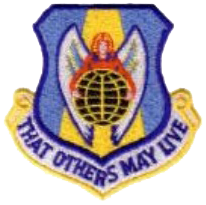
305th Rescue Squadron

The 305th Rescue Squadron (RQS), an Air Force Reserve unit located at Davis-Monthan Air Force Base (AFB), Ariz., is assigned to the 943rd Rescue Group, which is assigned to the 920th Rescue Wing at Patrick AFB, Fla. The commander of the 305 RQS is Lt. Col. Clifton D. Shuman.
Mission
PEACETIME: The 305 RQS trains personnel, with equipment, to achieve and maintain the capability to perform day/night combat rescue missions; search for, locate and recover United States Air Force and other Department of Defense personnel involved with United States defense activities; provide search and rescue support of civilians as directed by the Air Force Rescue Coordination Center; and provide humanitarian and disasterThe 305th Rescue Squadron (RQS), an Air Force Reserve unit located at Davis-Monthan Air Force Base (AFB), Ariz., is assigned to the 943rd Rescue Group, which is assigned to the 920th Rescue Wing at Patrick AFB, Fla. The commander of the 305 RQS is Lt. Col. Clifton D. Shuman. relief operations at the request of foreign governments and the International Civil Aviation Organization (ICAO).
WARTIME: Upon recall to active duty, the gaining command is Air Combat Command (ACC), Langley AFB, Virginia.
Organization
The 305th is a flying unit consisting of aircrew members (pilots, flight engineers, and pararescue specialists), and support personnel in maintenance, operations, and administration.
Aircraft
The 305th is assigned the HH-60G Sikorsky Pave Hawk twin-engine helicopter.
History
The 305 RQS was established at Selfridge AFB, Michigan, in April 1958 with four SA-16A Albatross aircraft and 90 personnel. Its mission was to conduct search and rescue operations in the area assigned by gaining command Military Air Transport Service, through Air Rescue Service.
From 1966 through 1992, the 305th was assigned the following aircraft: HC-97 Stratocruisers, HC-130 Hercules, and H-3 Jolly Green Giant. During the squadron's tenure at Selfridge AFB, they were recalled to active duty to support search and rescue mission taskings worldwide to include deployed locations in Libya, Spain, North Africa, Greece, Germany, Italy, England, Iceland, Southeast Asia, and Korea.
The 305th continued its support of local peacetime rescue while maintaining combat deployable status to include the following accomplishments: the dramatic recovery of 11 seamen from a sinking Canadian freighter in Lake Erie; transport of 14 workers critically injured from a factory accident; successful participation in foreign training exercises with Brazil, Honduras and Venezuela; Qualification Test and Evaluation of the Air Force C-130 Self-Contained Navigation System; space shuttle support; and search and rescue standby at Keflavik, Iceland.
In 1985, a 305th helicopter crew earned the Korean Kolligan, Jr. Trophy, the highest safety award in the Air Force, for successfully landing their severely disabled H-3 helicopter after one of the engines exploded.
In 1991, pararescue personnel deployed to the Persian Gulf to support the Liberation of Kuwait.
In 1992, with the draw down of active and reserve forces, the squadron's HC-130 aircraft were transferred to active duty and the H-3 helicopters were retired. The 305th Rescue Squadron was inactivated September 30, 1992.
On March 1, 1994, the 71st Special Operations Squadron, located at Davis-Monthan AFB, Ariz. was deactivated and reactivated as the 305th Rescue Squadron. The 305th assumed all personnel and assets of the 71st upon its inactivation and return from a 6-month tasking at Operation Provide Comfort II. The squadron was tasked to support Operation Provide Comfort II, 10 months after beginning the conversion to HH-60G Pave Hawk helicopters. The squadron deployed three HH-60G Pave Hawks and 95 personnel and accomplished 315 combat sorties.
On June 30, 1994, two aircrews received the 1993 Reserve Officers Association Major General Tom E. Marchbanks, Jr. Memorial Award for their heroic efforts in providing security for a British Harrier which crashed in the northern no-fly zone of Iraq on November 23, 1993, while deployed in support of Operation Provide Comfort II.
On May 19, 1994, the 305 RQS was credited with their first save. The crew completed a daring night rescue using night vision goggles and a stokes litter to hoist an injured Army specialist from a sixty degree mountain slope surrounded by forty- to sixty- foot trees.
The 305th continues to support local peacetime rescues while maintaining combat deployable status. During the performance of 17 rescue missions from May 1994 to September 1996, the squadron was credited with saving 10 lives and assisting with an eleventh.
Since its activation, the squadron continues to lead the way in combat search and rescue. The 305th Rescue Squadron was the first and only Reserve helicopter unit to achieve a shipboard operations capability; The unit has been presented three Air Force Outstanding Unit Awards for the time periods June 1, 1992 to May 31, 1994; October 1, 1993 to August 31, 1995; and September 1, 1997 to August 31, 1999.
In 2002 the 305th Rescue Squadron was activated for one year under the partial mobilization order to participate in Operations Enduring Freedom and Southern Watch, at Al Jaber AB in Kuwait.
The 305th Rescue Squadron continues to support Air Expeditionary Force Five and Six by rotating personnel and equipment through the various contingencies throughout the world including Operation Northern Watch and Southern Watch.
(Current as of April 2005)
40th Helicopter Squadron
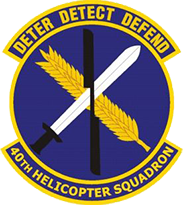
The 40th Helicopter Squadron, assigned to Malmstrom AFB, Mont., began as Detachment 5 of the 37th Air Rescue and Recovery Squadron and was one of seven detachments in the 37th ARRS under Military Airlift Command. The 37th ARRS was activated during the Korean War when helicopters were first used for medical evacuation. After the Vietnam War, 37th ARRS was deactivated, only to be reactivated in December 1973.
The 37th ARRS has been in service since March 21, 1968 and has carried out numerous search and rescue operations in combat areas throughout Southeast Asia, participated in the evacuations of Phnom Penh, Cambodia, Saigon, Vietnam and also provided service during the assault on Koh Tang Island during the Mayaguez incident.
Malmstrom AFB has had helicopters assigned since December 1964 under the Strategic Air Command structure and the 40th Rescue Flight was activated on May 1, 1993, Air Combat Command, Air Force Space Command and subsequently, Air Force Global Strike Command. In April 1998, the unit was redesignated as the 40th Helicopter Flight, and in October, 2005, the unit was redesignated the 40th Helicopter Squadron.
The 40th Helicopter Squadron ensures strategic security by providing flexible, rapid-response helicopter airlift support to the 341st Missile Wing. The 40th also performs aerial surveillance of Department of Defense strategic weapon convoys and short notice emergency security forces responses; supports emergency war order taskings, and priority personnel and logistical transportation. The 40th Helicopter Squadron has a proud rescue history and currently conducts search and rescue missions in support of the Joint Chiefs of Staff National Search and Rescue plan.
The 40th HS currently employs the UH-1N "Iroquois" helicopter, commonly known as the "Huey," a name that stems from its original designation of utility. The aircraft can carry up to 13 passengers at a maximum gross weight of 10,500 lbs. It has a range of 300 miles and can travel at a maximum airspeed of 130 knots (approximately 145 miles per hour). To date the unit has saved more than 370 lives and since 1973 has accumulated over 125,000 accident-free flying hours. The men and women of the 40th Helicopter Squadron are proud of their military heritage and continue to strive for excellence and better service for the 341st Missile Wing.
581st Air Resupply and Communications Wing
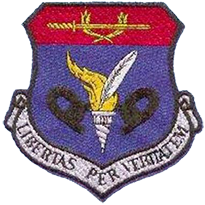
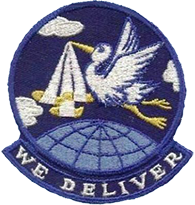
1st Patch - Libertas Per Veritatem (Liberty Through Truth)
2nd patch - Believed to be 581st Air Resupply and Communications Squadron Patch; however this may be a reunion patch
AIR RESUPPLY AND COMMUNICATIONS SERVICE (ARCS)
A subcommand of Military Air Transport Service (MATS), it was activated on 23 February 1951. The Idea was to combine several overt and covert intelligence and propaganda missions into a single organization. In April 1951, a somewhat vague mission statement was issued: "provide worldwide air resupply and communications service to all Air Force and other U.S. military activities requesting such service."
In 1951 the 581st ARCW, located at Mountain Home AFB, Idaho was ordered to re-locate to Clark AF, Philippine by July 1952. The wings B-29's rotated and was co-located with the 91st Strategic Reconnaissance Wing at Yakoto AB, Japan. The 581st SA-16 Albatross’s and H-19A's were used to conduct agent operations. In October 1952, a small detachment, of four new H-19A's (51-3883, 51-3884, 51-3885, 51-3886), was sent to Korea to operate under the Fifth United States Air Force for the insertion and retrieval of agents. The four H-19A's were attached to the 2157th Air Rescue Squadron (ARS), at K-16, for maintenance and housing support. Attaching the four H-19A's to the 2157th ARS gave the 581st ARCW cover for their secret activities. The 581st's H-19A's had the secondary mission of air crew recovery.
The first ARCW helicopter pilots had a few adjustments to make, beginning with the fact that when they arrived, on 5 October 1952, in Korea with no helicopters and no idea of the ARCW mission. When the newly arrived pilots contacted Fifth Air Force staff officers about their helicopters and a mission, the initial response was denial that the 581st even existed! It did, of course, and by October 1952 , six pilots, one NCO, 12 airmen fresh from tech school and four factory fresh H-19A's comprised the Helicopter Flight, commanded by Capt. Frank Westerman. Also know to be with the unit was Capt. Joe E. Barrett, Capt. Frank M. Fabijan, 2nd Lt. Robert F. Sullivan, Lawrence (Joe) A. Barrett, Rut Garnett, Don Crabb, Sergeant Jackabowski and A3C Ray Logan, plus others.
For the 3rd Air Rescue Group (ARGp.) the presence of the 581st ARCW helicopters took some adjustments as well. The 3rd ARGp commander objected to the night missions planned for the 581st H-19A's. He expressed his objection to Lt. Col. George Pittman, the 581st ARS commander that "helicopter flying at night was too dangerous". Col. Pittman bluntly reminded him that the 3rd ARGp. was responsible for providing maintenance and living arrangements for the 581st crews. As for the rest of their activities, "It's none of your business, don't worry about what we're doing". The 3rd ARGp. commander ordered the "rescue" markings removed from the 581st's H-19A's. Eventually, the 581st's H-19A's would be, like the 581st's SA-16's, painted black overall.
The 581st Helicopter Flight logged nearly a thousand hours in Korea. This included both the agent mission and air rescue flights to pick up downed pilots, all without a single accident, combat loss, or fatality. They had survived low-level night flying, North Korean ground fire, air-to-air interception, and ambush attempts on the ground.
Lineage
Established as 581st Air Resupply and Communications Wing on 9 Jul 1951. Activated on 23 Jul 1951. Inactivated on 8 Sep 1953.
Assignments
Air Resupply and Communications Service, 23 Jul 1951; Thirteenth Air Force, 18 Jul 1952 08Sep 1953.
Components
Group, 581st 23 Jul 1951 - 8 Sep 1953 (not operational, 17 Apr 1952 - 8 Sep 1953). Squadron, 581st: attached 17 Apr 1952 - 8 Sep 1953.
Stations
Mountain Home AFB, Idaho, 23 Jul 1951 - 26 Jun 1952; Clark AB, Philippines, 18 Jul 1952 - 8 Sep 1953.
Commanders
LtCol Rupert E. Herr, 23 Jul 1951; Col John K. Arnold, Jr., 1 Aug 1951; Maj John F. Zinn, 10 Aug 1951; LtCol George H. Pittman, Jr., 31 Aug 1951; Col John K. Arnold, Jr., 1 Oct 1951; Col Lawrence C. Gilbert, 16 Jan 1952; Col John K. Arnold, Jr., c. 18 Feb 1952; Col Lawrence C. Gilbert, 12 Jan-8 Sep 1953.
Aircraft
C-119, 1951-1953; B-29 1951-1953; SA-16, 1951-1953; H-19, 1952-1953; C-54; C-118, 1952-1953.
Operations
Performed psychological warfare and unconventional operations. Conducted limited operations in French Indo-China in 1953.
Service Streamers
None
Campaign Streamers
None
Decorations
None
Emblem
On a shield azure, a torch, base argent, flame or flame moving toward the dexter over the flame a quill argent bend sinister all between three links of a chain sable, the center link coupled, with one and one-half links on each side of the torch; on a chief gules two branches of olive, surmounted by a sword in fess, hilt and pommel to the dexter, all or. Motto: Libertas Per Veritatem—Freedom through Truth. (Approved on 12 Jun 1952.)
Reference: "Apollo's Warriors" by: Col. Michael E. Haas, "Twilight Warriors" by: Curtis Peebles & January 1995 issue of the "ARC Light"
Integrity, Honor, and Respect
Some of the best things cannot be bought, they must be earned
©2023 USAF Rotorheads All Rights Reserved | Financial Statement
